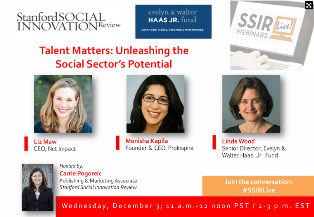Winning the Talent Game

This blog originally appeared in the Stanford Social Innovation Review as part of the Talent Matters series which Net Impact co-curated. Talent Matters highlights stories from the field and real-world results nonprofits and foundations have achieved by making talent and leadership a higher priority. Read more from Talent Matters, here.
 Tiffany T. is the kind of young woman that could become a nonprofit lifer. She’s smart, articulate, and above all else committed to making a difference in the world. But as she started her job search and senior year at UC Berkeley last fall, Tiffany set her eyes not on the nonprofit sector but on mission-driven business. Now a recent graduate, she's working within the corporate citizenship department of a Fortune 100 company. “I’m happy working at a big company, because I feel like they really have the capacity to inspire others and make change in the world,” says Tiffany.
Tiffany T. is the kind of young woman that could become a nonprofit lifer. She’s smart, articulate, and above all else committed to making a difference in the world. But as she started her job search and senior year at UC Berkeley last fall, Tiffany set her eyes not on the nonprofit sector but on mission-driven business. Now a recent graduate, she's working within the corporate citizenship department of a Fortune 100 company. “I’m happy working at a big company, because I feel like they really have the capacity to inspire others and make change in the world,” says Tiffany.
It used to be that if you wanted to make a difference on social or environmental causes, your options were pretty clear: You went to work in the nonprofit or public sectors. Today, we see from Net Impact members and students like Tiffany that options are much more expansive. You can go work at a nonprofit, but you can also go work at a start-up company or even a big corporation. Today, many companies are using the B-Corps logo to attract young, values-based talent to work in their ranks. And sustainability recruiter Ellen Weinreb reports that these days the only piece of recruiting collateral many corporations bring to campus is a sustainability report.
The fact that companies are now competing for mission-driven talent is, of course, a good thing. To address the problems we face on a global scale, we need people in all sectors to use their day job to make a difference. At the same time, this blurring of lines creates a new challenge for the social sector: We’re competing for talented, mission-driven prospective employees.
Nonprofits can no longer assume that passionate do-gooders will flock automatically to our job postings. We need to enhance our “employer brand” (to borrow a term from companies) to demonstrate all that we have to offer prospective employees—mission and beyond.
In our 2012 “What Workers Want” report, Net Impact and Rutgers University identified the top three priorities college students and college-educated professionals have for their job: a positive culture (90 percent), work-life balance (88 percent), and interesting work (96 percent).
Nonprofits can readily compete, and even outperform, the for-profit sector in these three areas. The fundamental nature of nonprofits—usually smaller, staffed by passionate people, and tackling really dynamic causes—sets us up for success and offers a recruiting advantage. There are a few specific ways I can see nonprofits building our employer brand.
1. Positive Culture. In our research for “What Workers Want,” 90 percent of survey respondents told us that a positive culture was a very important or essential priority in their job. Much has been made of companies like Zappos, which espouses its zany corporate culture at every turn (“create a little weirdness” is one of the company’s core values). But nonprofits can play this game too. We tend to attract good-hearted, passionate people who care about both their cause and colleagues. Some nonprofits even celebrate their personality and values with culture books (seeDo Something’s or Net Impact’s culture deck for inspiration).
2. Work-Life Balance. Of our survey respondents, 88 percent identified work-life balance as very important or essential to their job satisfaction. While many nonprofits already keep this balance at a reasonable level, the sector needs to do a better job of communicating this fact when hiring new talent. To bring this to life at an organization, first identify which of your balance norms might be most appealing to recruits (it will likely depend on the seniority level or day-to-day responsibilities of a position). Examples I’ve seen include “no email weekends,” giving employees a bonus day off for holiday shopping or birthdays, and open policies on flex time.
3. Interesting Work. As author Daniel Pink describes in his book Drive: The Surprising Truth About What Motivates Us, people are highly motivated by a sense of mastery, or the urge to get better and better at something that matters. Here is another lever nonprofits can pull: We have endless projects to tackle and opportunities to grow. Organizations can make sure even the most junior employees have a chance to contribute to interesting and important work, giving them outstanding professional development opportunities in the process. After all, the 70-20-10 ruleshows that 70 percent of learning on the job comes from doing, versus 20 percent by mentoring or coaching, and 10 percent from classroom training.
If nonprofits can work together to establish a more cohesive employer brand around “mission and,” we can attract the best talent in the world to grow our organizations and drive transformative change.
As we’ve heard time and again in this series, hiring is often a secondary priority for busy nonprofit executives; it comes after work on strategy, fundraising, and program development. But if we don’t attract the right people to work on our strategy (or fundraising or programs), it will take much more time to meet our goals—and the issues we tackle every day are too important to wait. It’s time for the nonprofit sector to get serious about competing in the talent game.


